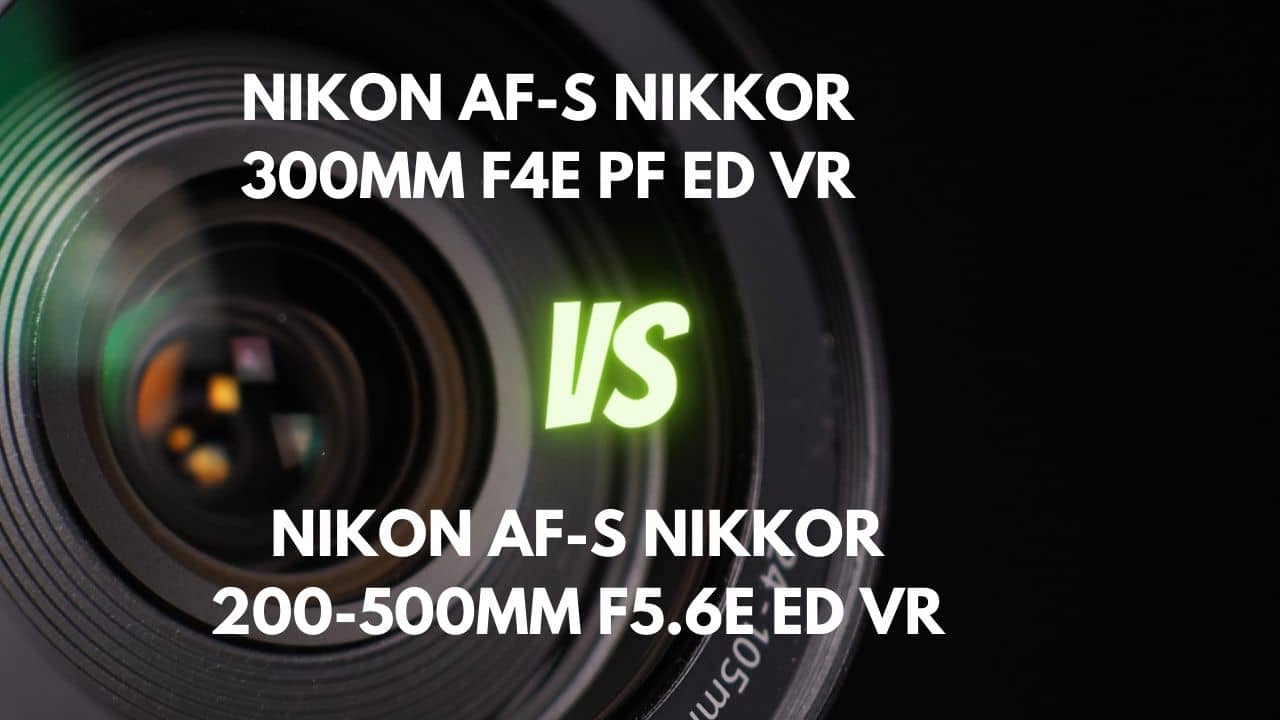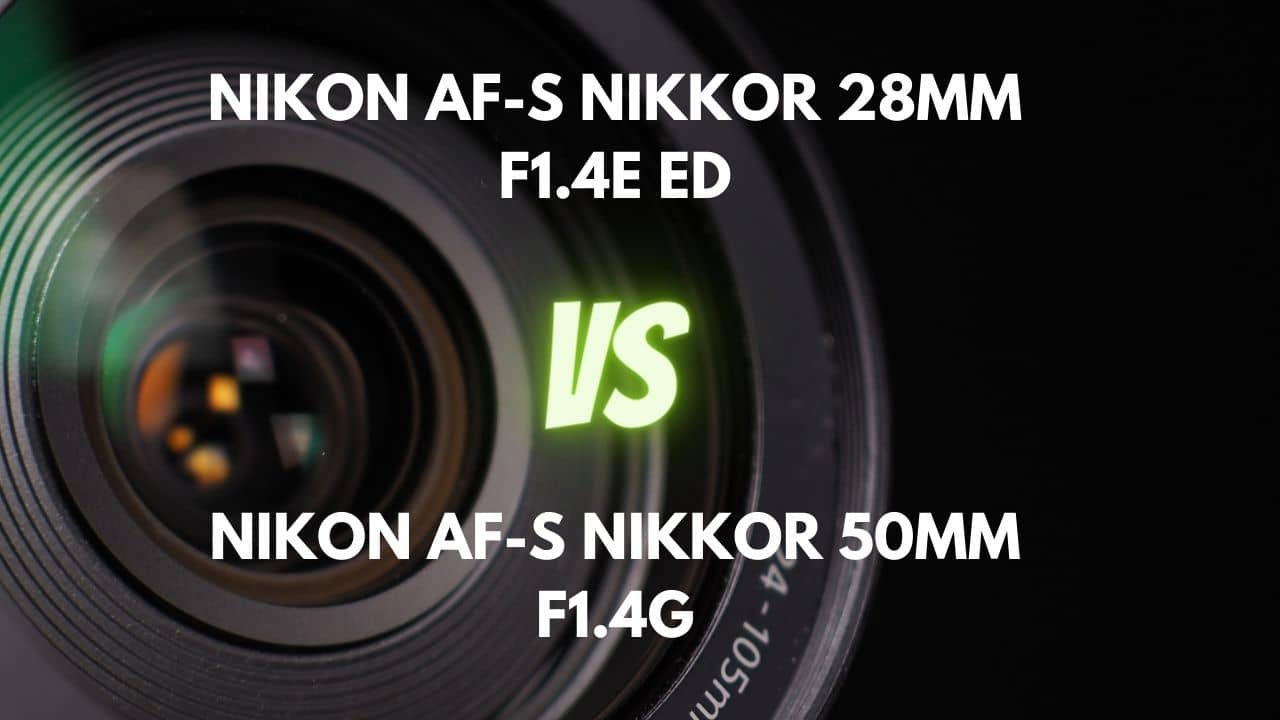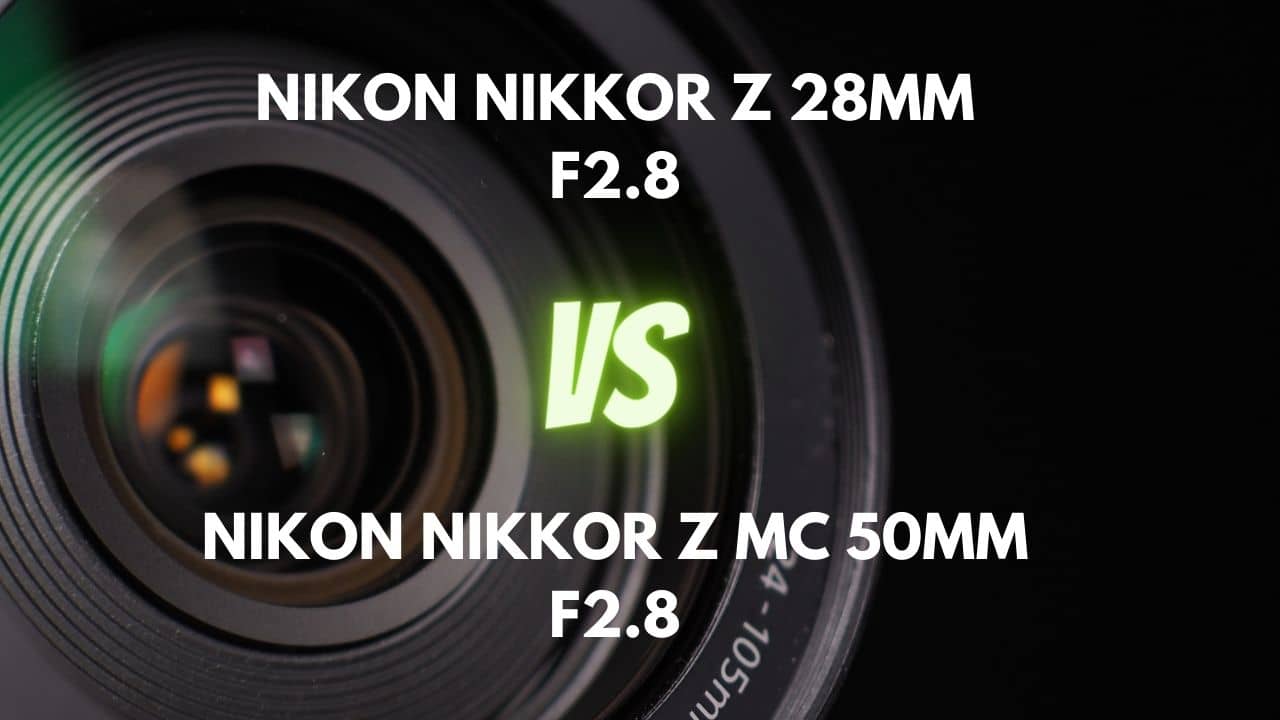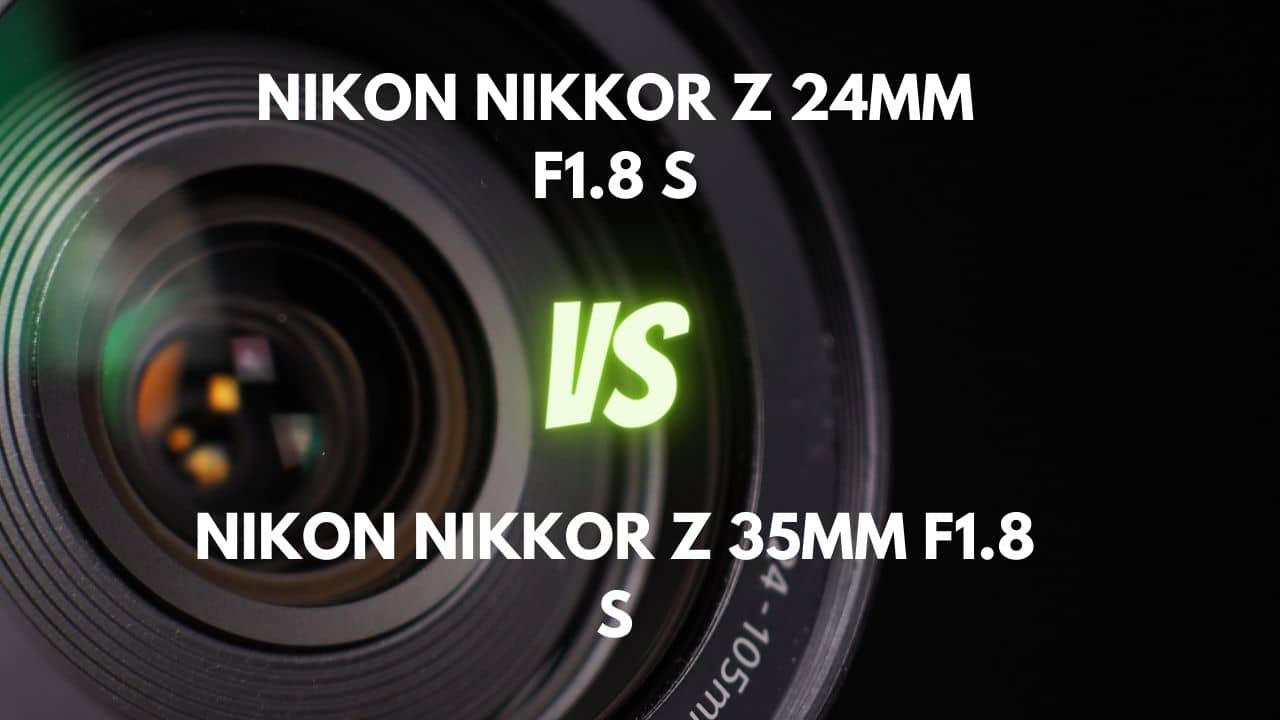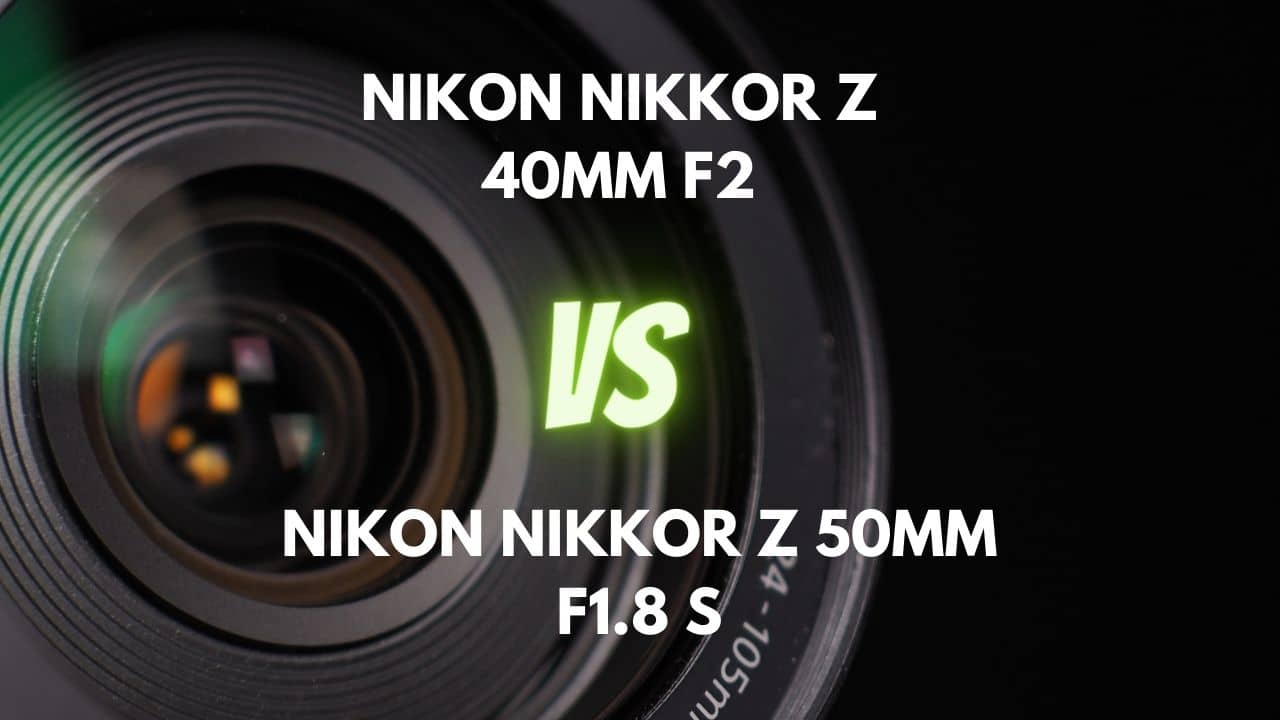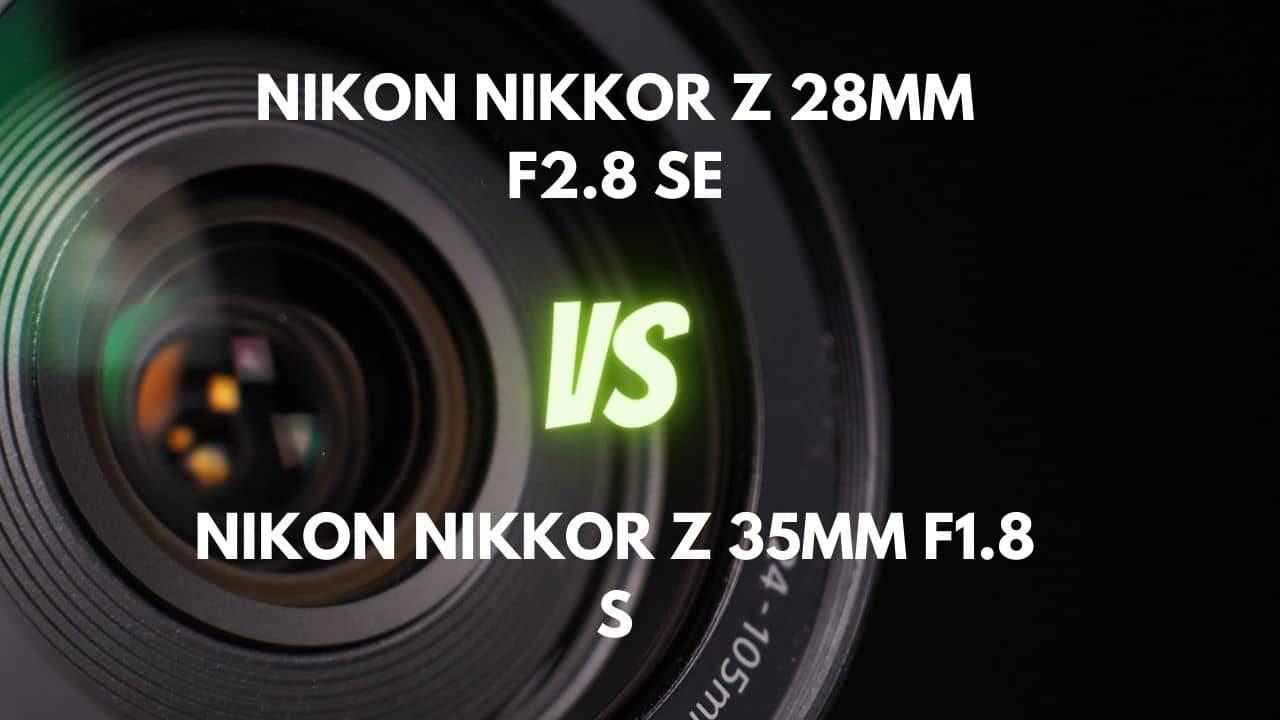Are you a dedicated photographer in search of that perfect lens that will take your shots from good to breathtaking? Perhaps you’re a landscape lover aiming to capture the grandeur of nature, a portrait artist seeking to highlight the nuances of human expression, or a videographer endeavoring to record life’s moments with cinematic precision. Whatever your specialty might be, the right lens can significantly enhance your craft and bring your artistic vision to life.
Enter the great debate: Nikon 24-70mm f/2.8 vs. Sigma 24-70mm f/2.8. As two of the leading giants in the world of photography, these brands offer top-tier lenses that promise to transform your photographic experience. This article will pit the Nikon lens against the Sigma lens, diving deep into their features, strengths, and potential drawbacks.
Whether you’re aiming for the creamiest bokeh, the sharpest image, or the most resilient gear for challenging weather conditions, we’ve got you covered. We’ll unpack each lens’s performance in various scenarios, giving you the information you need to make an informed decision. By understanding the nuances of these lenses, you can choose the one that not only meets your technical requirements but also aligns with your unique creative style.
So, brace yourself for an exciting journey into the world of photography equipment, where we’ll explore everything from focus breathing to chromatic aberration control. Not only will this comparison help you select the lens best suited to your needs, but it will also broaden your knowledge of photography, helping you make the most of your camera, regardless of the lens you choose.
So, get ready, photographers and videographers alike, as we dive into this comprehensive exploration of two remarkable lenses. This comparison could be the key to unlocking your next level of photographic or cinematic excellence. So, let’s embark on this enlightening adventure and find out which lens — Nikon or Sigma — truly deserves a place in your gear bag.
Overview
| Nikon AF-S NIKKOR 24-70mm F2.8E ED VR | Sigma 24-70mm F2.8 DG OS HSM Art Nikon F (FX) | |
|---|---|---|
| Max Aperture | F2.8 | F2.8 |
| Aperture Type | Fixed | Fixed |
| Focal Range (mm) | 24-70 | 24-70 |
| Mount Type | Nikon F (FX) | Nikon F (FX) |
| Max Format | 35mm FF | 35mm FF |
| Zoom Ratio (X) | 2.9 | 2.9 |
The Nikon 24-70mm f/2.8 and Sigma 24-70mm f/2.8 presented here share a number of similarities, with both lenses featuring a fixed maximum aperture of f/2.8, a focal range of 24-70mm, and compatibility with the Nikon F (FX) mount. They also both cater to the 35mm full-frame format, which is standard for many professional DSLR and mirrorless cameras.
Starting with the Nikon lens, as a product of Nikon, one could expect a high level of compatibility and performance with Nikon cameras due to the shared ecosystem. This lens offers a fixed aperture of f/2.8, which means that it maintains the same maximum aperture throughout the entire zoom range. This is beneficial for low-light photography, as it allows for a consistent amount of light to reach the sensor regardless of your zoom setting. It also contributes to a uniform depth of field and image quality across the zoom range, which can be useful for achieving consistent results in various shooting conditions.
Similarly, the Sigma lens also offers a fixed aperture of f/2.8 and a focal range of 24-70mm. Sigma is well-known for producing high-quality lenses that often rival those of the original camera manufacturers. Despite not being a native Nikon lens, it is designed to be fully compatible with the Nikon F (FX) mount, so you should expect similar levels of performance and functionality.
When comparing these two lenses, it’s important to keep in mind that the maximum aperture of f/2.8 is quite wide, allowing for good low-light performance and a shallow depth of field when desired. The fact that both lenses maintain this maximum aperture across the entire zoom range further enhances their flexibility and performance in various lighting conditions.
In conclusion, both the Nikon and Sigma lenses would be excellent choices for photographers seeking a versatile lens with a wide, fixed aperture and a popular zoom range.
Design and Ease of Use
| Nikon AF-S NIKKOR 24-70mm F2.8E ED VR | Sigma 24-70mm F2.8 DG OS HSM Art Nikon F (FX) | |
|---|---|---|
| Diameter x Length (mm) | ⌀88×154.5mm | ⌀88×108mm |
| Weight (gr) | 1070 | 1020 |
| Filter Thread (mm) | 82 | 82 |
| Weather Sealing | Yes | Yes |
| Zoom Method | Rotary (internal) | Rotary (extending) |
| Distance Scale | Yes | Yes |
| DoF Scale | No | No |
| Hood Supplied | Yes | Yes |
| Hood Code | HB-74 | LH876-04 |
The Nikon 24-70mm f/2.8 and Sigma 24-70mm f/2.8 in question vary significantly in their physical characteristics, which can have a tangible impact on their practical use.
The Nikon lens, with a diameter of 88mm and length of 154.5mm, is relatively large and heavy, weighing in at 1070 grams. Its size and weight may make it less portable and more tiring to use for extended periods. However, it employs an internal rotary zoom method, which means the lens doesn’t physically extend when you zoom in or out, maintaining a consistent size and balance. This can be an advantage when handling the camera, especially during long shooting sessions. Additionally, internal rotary zoom lenses are often easier to weather-seal, providing more protection against dust and moisture. However, this feature’s complexity might contribute to its greater weight and potentially higher price.
On the other hand, the Sigma lens is slightly smaller and lighter, with a diameter of 88mm, length of 108mm, and weight of 1020 grams. These dimensions make it more compact and lighter to carry, potentially offering a more comfortable shooting experience, especially when walking around for extended periods. However, this lens utilizes an extending rotary zoom method, which means the lens physically extends when you zoom in or out. This can alter the camera’s balance, potentially making it harder to handle, especially at longer focal lengths. Moreover, extending zoom lenses can be more challenging to weather-seal effectively, making them potentially more vulnerable to dust, moisture, and other elements.
In conclusion, both lenses have their pros and cons. If you prioritize a consistent balance and weather-sealing, the Nikon lens’s internal rotary zoom and robust build might appeal to you, despite its larger size and weight. However, if portability and a more compact form factor are essential to you, the Sigma lens might be the better choice, provided you’re comfortable with the extending rotary zoom mechanism and potential shifts in balance.
Lens Mount and Barrel
The Nikon 24-70mm f/2.8 and Sigma 24-70mm f/2.8 demonstrate varied approaches to the design of their lens mounts and barrels, both of which are vital aspects of lens construction, affecting the durability, usability, and overall experience of the lens.
The Nikon lens boasts a metal lens mount, which ensures a robust and secure connection to the camera body. Its incorporation of weather-sealing via an O-ring further enhances the mount’s durability, providing an additional line of defense against dust and moisture. This helps in maintaining the lens’s performance in varying shooting environments.
The lens barrel of the Nikon lens, constructed from a blend of high-grade plastic and metal, brings together the best of both worlds – the lightweight property of plastic and the durability of metal. The rubberized texture finish enhances the grip, making it easier to handle during shoots.
Conversely, the Sigma lens also employs a sturdy metal lens mount but enhances its weather-sealing with a rubber gasket. This gasket forms a secure seal against the camera body when compressed, adding another layer of protection against dust and moisture.
In terms of the lens barrel, the Sigma lens introduces a more complex blend of materials. It combines the resilience of metal with the thermal stability of the composite (TSC), ensuring that the lens remains durable and resistant to temperature-induced changes. The smooth and comfortable shape of the barrel, coupled with the polycarbonate construction of the inner barrel, provides an ergonomically pleasing and functional design.
In essence, both the Nikon and Sigma lenses display thoughtful design and material choices for their lens mounts and barrels. The Nikon lens offers a combination of high-quality materials with a focus on secure connections and weather resistance. Meanwhile, the Sigma lens goes a step further in weather protection and incorporates a thermally stable composite in its barrel design for added resilience against temperature variations.
Choosing between the two largely depends on your specific needs as a photographer. If you seek a lens with a balanced mix of durability construction, the Nikon lens could be a superior choice. However, if you often shoot in variable temperature conditions and prioritize advanced weather protection, the Sigma lens might be more suitable. Both lenses highlight the importance of considering the materials used in the lens mount and barrel as integral components of your lens selection process.
Weather Sealing
The Nikon 24-70mm f/2.8 and Sigma 24-70mm f/2.8 exhibit different degrees of weather sealing, which is an essential feature for photographers who frequently shoot in varying environmental conditions. Weather sealing plays a significant role in protecting the lens from elements like dust, moisture, and water splashes, thus safeguarding its performance and longevity.
The Nikon lens possesses a high level of weather resistance. It’s designed to ward off water, dust, and smudges effectively. The inclusion of a rubber grommet seal at the lens mount, along with internal seals at various points such as the rings, switches, and the front of the barrel, fortifies the lens against harsh weather conditions.
However, it’s worth noting that while the lens is robust and built to endure challenging conditions, extreme weather scenarios or sudden changes in temperature can potentially lead to issues like condensation and moisture build-up inside the lens.
On the other hand, the Sigma lens features a dust- and splash-proof design. Its weather resistance is chiefly concentrated at the mount with a rubber sealing, providing a first line of defense against dust and moisture. While it may not have extensive weather sealing throughout the entire barrel like the Nikon lens, it still manages to perform admirably in difficult conditions.
A noteworthy feature is the front lens element, which has a water- and oil-repellent layer, thus making the lens more resilient in rainy, dusty, or water-near conditions. The use of metal and thermally stable composite (TSC) materials further enhances the lens’s robustness, enabling it to withstand various shooting environments.
In conclusion, both lenses demonstrate commendable weather-sealing capabilities, tailored to withstand harsh conditions. The Nikon lens offers more comprehensive weather sealing throughout the lens, making it a strong contender for photographers frequently shooting in challenging weather conditions. However, the Sigma lens, with its targeted weather sealing and water- and oil-repellent front element, also delivers robust performance, particularly for those working near water or in dusty environments.
Rings
The Nikon 24-70mm f/2.8 and Sigma 24-70mm f/2.8 possess distinct ring designs that cater to different photographer preferences, contributing to the ease of operation, precision, and overall user experience.
The Nikon lens incorporates two rings: a rubberized zoom ring at the back and a manual focus ring towards the front. The zoom ring, characterized by its wide grip and raised ribs, provides an excellent tactile experience, ensuring smooth rotation with subtle resistance. It allows you to shift from wide to telephoto views with a simple quarter turn, enhancing speed and convenience.
The focus ring, albeit narrower, remains equally grippy and smooth, featuring soft stops at the minimum focus distance and infinity for fine adjustments. A key feature is the windowed distance scale, displaying focus distances in both feet and meters, although it lacks infrared (IR) or depth of field (DOF) markings. The lens lacks a lock switch for the zoom ring, but an inner barrel movement ensures the lens hood remains stable during zooming.
Conversely, the Sigma lens has a zoom ring located towards the front and a focus ring closer to the camera mount. Both rings are rubberized and sharply-ribbed, enhancing grip and user experience. The thin manual focus ring rotates smoothly, enabling precise focus adjustments, and includes a windowed distance scale in both feet and millimeters. It offers a comfortable rate of focus distance adjustment with a 95-degree rotation.
The zoom ring operates smoothly with minimal effort, featuring focal length markings at the front and rotating in the same direction as Canon lenses. The lens extends slightly at 70mm when using the zoom ring but includes a lock switch to maintain its retracted position. Importantly, the lens doesn’t exhibit zoom creep, ensuring consistent focal length during shooting.
In conclusion, both lenses offer compelling ring designs, contributing to their overall usability and functionality. The Nikon lens stands out with its wide, grippy zoom ring and intuitive quarter-turn zoom operation, which may be appreciated by photographers prioritizing fast and fluid adjustments. However, the Sigma lens shines with its precise manual focus ring and lockable, smooth-operating zoom ring, potentially appealing to photographers desiring meticulous control over their lens adjustments.
Switches/Buttons
The Nikon 24-70mm f/2.8 and Sigma 24-70mm f/2.8 each feature distinct switches/buttons, with their respective designs influencing user interaction and overall shooting experience.
The Nikon lens incorporates two switches on the barrel side: the AF/MF switch and the VR switch. The AF/MF switch facilitates seamless transition from autofocus to manual operation, reducing time lag and enhancing shooting efficiency. The VR switch provides different settings for Off, Normal, or Active VR modes, allowing for flexibility depending on shooting conditions. However, a potential drawback is that the switches are identical to touch, which might cause confusion when selecting quickly based solely on feel.
On the other hand, the Sigma lens sports two main switches on the barrel side. The AF/MF switch, similar to the Nikon lens, offers three positions: autofocus (AF), manual focus (MF), and manual override (MO), the latter enabling immediate manual focus adjustment without waiting for autofocus lock. The second switch is for the optical stabilizer (OS), offering a straightforward on/off function without a secondary panning mode. These switches provide click confirmation, enhancing user confidence during operation. A unique feature of the Sigma lens is the customizable button defaulting to autofocus lock and a zoom lock switch. This low-profile switch bank is conveniently positioned for left thumb use and requires the right amount of force for switch manipulation. The white background behind the focus mode switch in AF mode adds a classy touch and enhances visibility in low light conditions.
In conclusion, both lenses offer user-friendly switches/buttons, enhancing operational ease and shooting efficiency. However, the Sigma lens, with its additional customizable button, zoom lock switch, and click confirmation for each switch position, offers a slightly superior user experience. The additional visibility provided by the white background in low light conditions further tilts the balance in Sigma’s favor. Thus, in terms of switches/buttons, the Sigma lens appears to have a slight edge over its Nikon counterpart.
Filter Thread
The Nikon 24-70mm f/2.8 and Sigma 24-70mm f/2.8 exhibit differing characteristics in terms of their filter threads, which play a pivotal role in their overall operation and user experience.
The Nikon lens comes equipped with an 82mm filter thread size, larger than its predecessor, implying a requirement for larger filters. However, its internal focusing mechanism ensures the filter remains stationary during focusing, which simplifies the use of filters such as circular polarizers or graduated neutral density filters. This fixed position reduces the need for continuous readjustment, hence enhancing the user experience.
On the other hand, the Sigma lens also sports an 82mm filter thread size, considered a standard for 24-70mm lenses. Its filter thread is composed of metal, guaranteeing enhanced durability and stability when attaching filters. Additionally, the front element and filter thread do not rotate during focusing, offering ease and convenience in using various filter types, such as polarizers and graduated neutral density filters. This non-rotating design further simplifies filter usage without any adjustments needed during focusing or zooming.
In essence, both lenses have similar filter thread sizes and non-rotating designs, allowing for easier use of specific filter types.
Lens Hood
The Nikon 24-70mm f/2.8 and Sigma 24-70mm f/2.8 both come with lens hoods, but they have distinctive features that set them apart.
The Nikon lens hood is a plastic petal-style hood labeled HB-74, conveniently included in the box. It features a lock mechanism, offering a secure attachment that resists accidental removal. The deep design of the hood not only mitigates lens flare but also provides protection to the front lens element.
Interestingly, the hood attaches to a bayonet just forward of the gold stripe on the barrel, not directly on the lens front, due to an inner barrel that adjusts with the zoom. This design means the hood doesn’t require readjustment while zooming, even though the coverage at 24mm is somewhat limited. The hood can be conveniently reversed for storage, making it a practical and well-designed accessory for the lens.
Conversely, the Sigma lens also comes with a lens hood in the box, crafted from robust molded plastic that can absorb impact. The interior of the hood is ribbed, reducing reflections and maintaining image contrast. Some parts of the exterior mount area are also ribbed or rubberized, facilitating a better grip during attachment and removal.
The hood, although modest in size, provides substantial protection against impact and flare-inducing light, particularly at the wide end of the range. The hood attaches to the lens smoothly and securely, enhancing its usability.
In summary, both lens hoods have their merits. The Nikon hood’s locking mechanism and deep design ensure efficient flare reduction and lens protection, while its unique mount allows for consistent coverage while zooming. The Sigma hood, on the other hand, is designed with a ribbed interior for optimal light reflection prevention, coupled with a sturdy construction for impact absorption. It provides excellent protection, especially at the wide end of the range.
Focusing and Optical Stabilization
| Nikon AF-S NIKKOR 24-70mm F2.8E ED VR | Sigma 24-70mm F2.8 DG OS HSM Art Nikon F (FX) | |
|---|---|---|
| Autofocus | Yes | Yes |
| AF Motor | Silent Wave Motor | Hyper Sonic Motor |
| Rotating Front Element | Does not rotate on focusing | Does not rotate on focusing |
| Min Focus Distance | 0.41m(24,28,70mm);0.38m(35-50mm) | 0.37m |
| Max Magnification (X) | 0.27 | 0.21 |
| Full-Time Manual Focus | Yes | Yes |
| Focus Method | Internal | Internal |
Focusing Performance
The Nikon 24-70mm f/2.8 and Sigma 24-70mm f/2.8 both offer impressive focusing performance, each with its unique features and strengths.
The Nikon lens boasts a swift and responsive autofocus, easily acquiring and shifting focus between subjects. Its virtually silent AF-S drive ensures quiet operation, making it ideal for video recording where ambient noise is a concern. The autofocus accuracy shines under various lighting conditions, snapping into focus almost every time, especially when paired with the latest-generation DSLR that has superior light sensitivity and an improved autofocus system.
The lens features a no-slack focus ring, facilitating manual focus override for more precise control. Moreover, it uses an internally focusing design, meaning the lens’ length remains unchanged irrespective of the focus and zoom settings, with the front element not rotating during focusing. Remarkably, this lens doesn’t exhibit focus breathing, a feature video creators will appreciate.
In contrast, the Sigma lens employs a Hypersonic Motor (HSM) for autofocus, resulting in rapid and accurate focusing. However, it tends to produce some operational noise, which could be noticeable when shooting videos with continuous autofocus. The autofocus speed is commendable, even in low-light conditions, and the initial autofocus acquisition speed is impressive, ensuring sharp images.
For more intricate control, the lens provides a manual focus override. The manual focus action is smooth, and like the Nikon, the Sigma lens also uses an internally focusing design, maintaining a constant lens length regardless of focus and zoom settings. Unlike the Nikon lens, though, the Sigma lens does exhibit focus breathing, which videographers may find problematic.
Summing up, both lenses deliver excellent focusing performance. The Nikon lens stands out with its nearly silent autofocus system and the absence of focus breathing, making it particularly suited for video work. The Sigma lens offers swift and precise focusing with the HSM, albeit with some operational noise and focus breathing.
Given the near-silent operation and lack of focus breathing, the Nikon lens demonstrates superior focusing performance, especially advantageous for video creators seeking smooth, quiet, and consistent focusing.
Optical Stabilization
The Nikon 24-70mm f/2.8 comes equipped with an optical stabilization feature, also known as Vibration Reduction (VR), which permits up to 4 stops longer exposure times. This results in robust image stabilization performance, even when using slower shutter speeds, a feature that proves beneficial when shooting in low light or capturing video.
The lens provides two modes of stabilization – Normal and Active, giving users the flexibility to adapt to different shooting scenarios. Additionally, the autofocus is driven by a fast and nearly silent AF-S drive, ensuring quiet operation of the VR system. This lens can deliver sharp handheld shots at speeds as long as 1/5-second when shooting at 70mm.
In contrast, the Sigma 24-70mm f/2.8 features an optical stabilization system (OS) that is effective up to 4 stops, slightly less effective compared to some competitors like the Tamron 24-70mm. This OS system is notably quiet, producing only a slight click during startup and shutdown, and a soft whirring sound when the lens is moved rapidly with the OS engaged.
Unlike the Nikon lens, the Sigma lens doesn’t offer multiple stabilization modes; it simply operates in an on or off capacity. Despite this, at 70mm, the lens delivers a significant percentage of sharp results at 1/8 second, a decent percentage at 1/6 second, and a reasonable keeper rate even at 1/5 second. Beyond 1/5 second, however, the rate of capturing sharp images drops considerably.
In summary, both lenses offer commendable optical stabilization capabilities, but they each shine in different aspects. The Nikon lens provides the advantage of two stabilization modes and a virtually silent operation, making it well-suited for diverse shooting conditions and video recording. On the other hand, the Sigma lens offers a simple, quiet, and effective OS system, though it lacks multiple modes and sees a significant drop in sharp image capture beyond 1/5 second.
Given its flexibility with two stabilization modes and superior silent operation, the Nikon lens edges out the Sigma lens in terms of superior optical stabilization performance.
Image Quality
| Nikon AF-S NIKKOR 24-70mm F2.8E ED VR | Sigma 24-70mm F2.8 DG OS HSM Art Nikon F (FX) | |
|---|---|---|
| Special Elements | 3 aspherical and 2 ED elements + nano crystal and fluorine coatings | 3 HLD and 4 aspherical elements |
| Diaphragm Blades | 9 | 9 |
| Circular Aperture | Yes | Yes |
Aberration
Starting with the Nikon 24-70mm f/2.8, it exhibits different levels of chromatic aberration. Lateral chromatic aberration is particularly high at 35mm, with peak values of above 3 pixels at the image borders. Longitudinal chromatic aberration (LoCA) is also present, leading to a slight magenta coloration in the foreground and greenish hues in the background.
However, the good news is that chromatic aberration can generally be corrected in post-production. The lens also exhibits some coma at various apertures and focal lengths in night shots, but the effect is not significant. Lastly, there is no considerable spherochromatism, and out-of-focus highlights remain reasonably neutral.
On the other hand, the Sigma 24-70mm f/2.8 shows some chromatic aberration, coma, and spherical aberration. However, these are well-controlled in most situations. Axial chromatic aberration and spherochromatism exist but are not a major concern for general use. Coma can be noticeable in the mid-frame and corners of wide aperture images but improves when the aperture is stopped down. Spherical aberration might lead to a hazy appearance at the widest apertures, but this issue generally resolves when stopped down one or two stops. Lateral chromatic aberration can appear in certain high-contrast situations, but it is generally minimal and can be corrected in post-processing.
The lens design integrates three SLD elements and four aspherical elements, along with a Super Multi-Layer Coating. These features effectively reduce distortion, aberrations, and color fringing in most scenarios. While minor chromatic aberration and coma might be noticeable when pixel peeping, the lens performs well in real-world use and should not cause significant problems for most photographers.
In conclusion, both lenses show some level of chromatic aberration and other aberrations, but these can be addressed in post-production or by adjusting the aperture. The Sigma lens, with its specialized design and coating, has an edge in controlling various aberrations and maintaining image quality. Therefore, in terms of superior aberration control, the Sigma lens is a better performer.
Sharpness
Beginning with the Nikon 24-70mm f/2.8, sharpness varies based on focal length and aperture. It displays strong center sharpness across the focal range, with the widest aperture rendering slightly softer results. A notable decline in sharpness is evident at 50mm and above, with the corners being most impacted. However, stopping down to f/5.6 significantly enhances sharpness. Despite some minor loss of sharpness, the lens performs admirably with a teleconverter. Generally, the peak sharpness lies between f/5.6 and f/8, depending on the focal length.
Switching to the Sigma 24-70mm f/2.8, it provides remarkable sharpness across the zoom range, peaking at 70mm. The center sharpness is robust, particularly at f/4 and narrower apertures. Corner sharpness is weaker at wider apertures, especially at 24mm, but improves substantially when stopped down to f/5.6 or beyond. The sharpest aperture is around f/9, and even at f/22, the performance remains solid with only a minor reduction in sharpness due to diffraction. Stopping down the aperture enhances sharpness, especially in the corners, making this lens suitable for detail-oriented photography such as landscapes.
Taking all factors into consideration, the Sigma lens appears to have a slight edge in overall sharpness and versatility across a wider range of apertures. Therefore, in terms of superior sharpness, the Sigma lens takes the crown.
Bokeh Quality
When evaluating bokeh quality, the Nikon and Sigma lenses both exhibit strengths and weaknesses, offering different styles of background blur.
In the case of the Nikon 24-70mm f/2.8, it provides a satisfactory bokeh, but it doesn’t excel in this area. The transition from focused to defocused areas can show some nervousness or inconsistency, and outlining or a “cat’s eye” effect due to mechanical vignetting may be observed when using large apertures. Additionally, bokeh fringing can occur at the edges, adding an undesirable coloration to the blur. However, the lens can create a three-dimensional effect where the sharply rendered subject appears to emerge from a softer background. Yet, for superior bokeh quality, it’s advised to opt for a dedicated portrait lens.
On the other hand, the Sigma 24-70mm f/2.8 is known for its smooth and aesthetically pleasing bokeh. The background blur appears pleasingly rendered with good contrast, and the out-of-focus highlights display an interesting pattern, giving a more attractive blur. The lens is designed for perfect circular bokeh, and its effective chromatic aberration control enhances the quality of the bokeh effect. Nevertheless, there can be some minor issues, such as a cat’s eye effect or onion bokeh, but these are typically faint and can be mitigated by stopping down the aperture slightly.
Considering the above factors, the Sigma lens seems to offer superior bokeh quality, producing a smoother and more aesthetically pleasing background blur, although both lenses bring their unique characteristics to the table.
Flare/Ghosting
Analyzing the performance of the Nikon 24-70mm f/2.8 and Sigma 24-70mm f/2.8 in terms of flare and ghosting, there are certain distinctions to note. Both lenses employ specific coatings to help mitigate these issues, which can detract from image quality, particularly when shooting in challenging lighting conditions.
The Nikon lens showcases good resilience against flare and ghosting, especially when the light source is distinctly outside the frame. However, flare can occur if the light source is near the image corner but still outside the frame. The lens uses a Nano Crystal Coat to minimize flare and ghosting, but direct sun exposure can still induce some artifacts. The severity of ghosting and flare can hinge on the placement of the bright light source within the frame. By carefully positioning the light source, you may be able to circumvent these issues. Even so, the lens can produce modest spots and veiling flare when exposed to intense lights within the image area.
Conversely, the Sigma lens demonstrates effective control of flare and ghosting in most scenarios. From apertures f/2.8 to f/8, ghosting is typically well-handled, though occasional green streaks may appear opposite the light source. However, when the aperture is constricted, ghosting becomes more noticeable, potentially producing green trails across the image.
One distinctive feature of the Sigma lens is its 11-bladed diaphragm, which yields 22-point sunstars, adding a creative touch to images with bright light sources. The lens benefits from a Super Multi-Layer Coating, designed to limit flare and ghosting, thus preserving image quality when shooting backlit subjects.
In conclusion, both lenses perform admirably in managing flare and ghosting. However, the Sigma lens offers a slight edge due to its superior ghosting control across a broader aperture range and its ability to generate 22-point sunstars. This lens should provide greater creative options and maintain higher image quality when photographing in challenging light conditions.
Vignetting
The Nikon 24-70mm f/2.8 and Sigma 24-70mm f/2.8 both exhibit vignetting, a phenomenon that causes the edges of an image to darken compared to the center. This characteristic can be influenced by aperture settings, focal lengths, and the specific design of the lenses.
The Nikon lens shows noticeable vignetting, especially at wider apertures and shorter focal lengths. It demonstrates a more significant level of vignetting compared to its predecessor. By stopping down the aperture, this effect can be considerably lessened. At f/5.6, although some vignetting remains, it is mostly negligible beyond this point. Moreover, any remaining vignetting can be effortlessly corrected using post-processing software.
On the other hand, the Sigma lens also displays clear vignetting, particularly at the wide and telephoto ends of the focal range when using wider apertures like f/2.8. As the aperture is narrowed down, the darkening effect reduces, becoming less obvious around f/5.6. The lens exhibits vignetting across the entire zoom range and at all apertures, with the most significant manifestation at 24mm and 70mm focal lengths. Like with the Nikon lens, post-processing software such as Adobe Lightroom can be used to apply lens profile corrections, effectively minimizing or eradicating vignetting.
In sum, both lenses manifest vignetting, a common occurrence in many lenses, particularly at certain focal lengths and apertures. While the Sigma lens shows vignetting throughout its zoom range, the Nikon lens appears to have a higher degree of vignetting at shorter focal lengths and wider apertures.
However, both lenses offer the possibility to reduce this effect by stopping down the aperture and through post-processing corrections. If vignetting is a critical factor in your photography, the Sigma lens might be slightly preferable, as its vignetting appears less severe and more evenly distributed across the zoom range. However, it’s also worth noting that some photographers may appreciate the artistic touch that a certain degree of vignetting can add to their images.
Distortion
When it comes to lens distortion, both the Nikon 24-70mm f/2.8 and Sigma 24-70mm f/2.8 exhibit varied degrees across their focal length ranges. This involves a combination of barrel and pincushion distortions, which warp the image by curving straight lines outwards or inwards, respectively.
Starting with the Nikon lens, it displays distinct barrel distortion at 24mm, morphing into pincushion distortion as the focal length extends from 35mm to 70mm. This variation can influence how your images appear, especially if they contain straight lines that can highlight the distortion.
Nonetheless, the lens design might have been intentionally optimized for corner sharpness, accepting some distortion as a trade-off. Though this might be a concern for certain photographers, any distortion can be readily corrected using post-processing software, such as Lightroom.
In contrast, the Sigma lens also displays varying distortion types throughout its focal range. At 24mm, barrel distortion is quite noticeable, along with some vignetting, yet corner sharpness improves when the lens is stopped down, making it a good choice for landscape photography.
As you zoom in towards 35mm, the barrel distortion lessens, giving way to pincushion distortion, which remains relatively minor throughout the longer focal lengths. Similar to the Nikon lens, any distortion can be managed using post-processing software with lens correction profiles, such as Adobe Lightroom.
In conclusion, both lenses exhibit comparable distortion characteristics, with the type of distortion shifting depending on the focal length used. However, the Sigma lens has a slight edge due to its modest pincushion distortion at longer focal lengths and improved corner sharpness at 24mm when the aperture is stopped down. That being said, the optimal choice will depend on your specific requirements and tolerance for distortion. While post-processing can correct these issues, shooting with minimal distortion from the outset is always ideal when possible.
Final Verdict
After carefully analyzing the features and performance of both the Nikon 24-70mm f/2.8 and Sigma 24-70mm f/2.8, we can draw some conclusions about their suitability for different photography genres.
For landscape photography, which often requires wide angles, good sharpness across the frame, and control over distortion and vignetting, the Sigma lens appears to have a slight edge. Its improved corner sharpness at 24mm when stopped down, better control of vignetting across the zoom range, and modest pincushion distortion at longer focal lengths make it a promising choice for capturing expansive landscapes.
In contrast, for event or action photography that often involves challenging lighting and weather conditions, the Nikon lens is the superior choice. Its extensive weather sealing, nearly silent autofocus system, and two stabilization modes make it well-suited for fast-paced, unpredictable environments where quick adjustments and resilience are key.
When it comes to video work, the Nikon lens’s near-silent operation, lack of focus breathing, and effective stabilization make it a standout choice. These features ensure smoother, quieter, and more consistent focus transitions, which are critical for high-quality video capture.
For portrait photographers, who often prioritize bokeh quality to make subjects stand out against a beautifully blurred background, the Sigma lens appears superior. Its ability to produce smoother and more aesthetically pleasing background blur can add a more professional and artistic touch to portrait shots.
In the realm of architectural photography, where control over distortion and sharpness across the frame is crucial, the Sigma lens might be the better option. Its modest pincushion distortion at longer focal lengths and improved corner sharpness at 24mm when stopped down can be advantageous when capturing buildings and structures.
In conclusion, Nikon’s lens excels in weather-resilience, focusing performance, and optical stabilization, while the Sigma lens offers advantages in aberration control, sharpness, bokeh quality, and distortion control. Remember, the best lens is not necessarily the one with the most features or the highest price, but the one that serves your needs and helps you capture your vision effectively.

